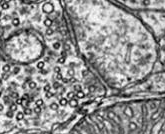Our lab's mission is to understand the organizational principles that underlie information processing in neural circuits.
Our work is guided by several key questions:
- What rules underly network connectivity?
- What network motifs are conserved and what differentiates brains - and brain regions?
- What are fundamental constraints on network behavior?
- How are such rules enforced during development?
We primarily use large-scale electron microscopy (EM) and in vivo multi-photon calcium imaging to examine the structure and function of neurons and networks. Serial EM provides us with detailed anatomical information about neurons and their connections. We can identify excitatory and inhibitory neurons and synapses, discover connectivity motifs, and analyze the organization of synaptic connections. The other key component of our approach is physiology – either optical imaging of activity sensors or electrophysiology. Ideally, the same cells are subjected to in vivo physiological recording and connectivity analysis. In this way we can infer how patterns of connectivity shape neuronal computations. Additionally, we use genetic tools for labeling and manipulation; and modeling to explore the implications of our data and generate testable theories. Finally, we are devising approaches that will allow us to use behavior to bridge our understanding of circuit structure and network computation. By working across these modes of inquiry we aim to uncover the fundamental building blocks of functional networks.
